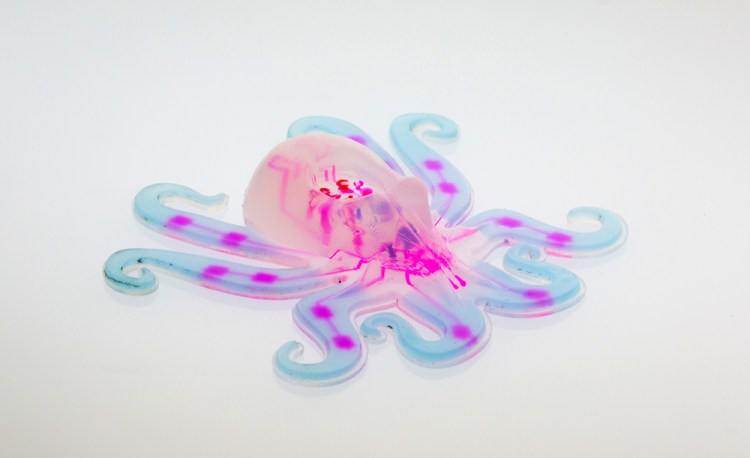WASHINGTON — The latest thing in robot research is squishy like Silly Putty, wireless, battery-less and made for pennies by a 3-D printer.
Octobot is fluid-powered and looks like a tiny octopus. A team at Harvard University, which has created about 300 of the palm-sized bots, hopes they will one day be capable of slithering through cracks and tight places, making them ideal for rescue scenarios.
The bots are described in Wednesday’s edition of the scientific journal Nature.
Jennifer Lewis, a Harvard professor of biologically inspired engineering, said soft robotics are important because when they interact – or collide – with humans, there is less risk of damage to either one.
So far, all Octobot can do is wiggle, so the current stage of research is just an “extremely simple first step,” Lewis said.
Initially it was supposed to be a spider, but the team wanted both swimming and crawling and it started to look more like an octopus, Lewis said.
A chemical reaction in fluids moves the arms and directs the robot’s actions. It can be printed cheaply by a 3-D printer with the most costly part a small bit of platinum. Aside from that it is essentially like bathroom caulk, “a rubbery-type object,” Lewis said.
Robotic experts are raving about the squishy machine.
In an email, Tufts University professor Barry Trimmer called it “an ingenious approach to building and controlling a completely soft robot.”
Daniela Rus at MIT said the invention was what the soft robotics community has been looking for: “The octopus robot is a first self-contained soft robot system whose components are all soft – it is a very beautiful machine.”
Nature video on other soft robot ideas:
Send questions/comments to the editors.



Success. Please wait for the page to reload. If the page does not reload within 5 seconds, please refresh the page.
Enter your email and password to access comments.
Hi, to comment on stories you must . This profile is in addition to your subscription and website login.
Already have a commenting profile? .
Invalid username/password.
Please check your email to confirm and complete your registration.
Only subscribers are eligible to post comments. Please subscribe or login first for digital access. Here’s why.
Use the form below to reset your password. When you've submitted your account email, we will send an email with a reset code.